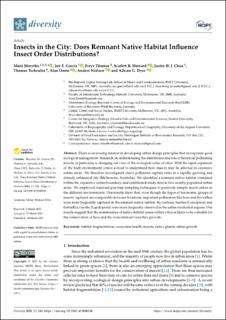| dc.contributor.author | Shrestha, Mani | |
| dc.contributor.author | Garcia, Jair E. | |
| dc.contributor.author | Thomas, Freya | |
| dc.contributor.author | Howard, Scarlett R. | |
| dc.contributor.author | Chua, Justin H. J. | |
| dc.contributor.author | Tscheulin, Thomas | |
| dc.contributor.author | Dorin, Alan | |
| dc.contributor.author | Nielsen, Anders | |
| dc.contributor.author | Dyer, Adrian G. | |
| dc.date.accessioned | 2022-02-21T10:29:08Z | |
| dc.date.available | 2022-02-21T10:29:08Z | |
| dc.date.created | 2022-01-16T17:44:54Z | |
| dc.date.issued | 2021-03-30 | |
| dc.identifier.citation | Diversity. 2021, 13 (4), . | en_US |
| dc.identifier.issn | 1424-2818 | |
| dc.identifier.uri | https://hdl.handle.net/11250/2980441 | |
| dc.description.abstract | There is increasing interest in developing urban design principles that incorporate good ecological management. Research on understanding the distribution and role of beneficial pollinating insects, in particular, is changing our view of the ecological value of cities. With the rapid expansion of the built environment comes a need to understand how insects may be affected in extensive urban areas. We therefore investigated insect pollinator capture rates in a rapidly growing and densely urbanized city (Melbourne, Australia). We identified a remnant native habitat contained within the expansive urban boundary, and established study sites at two nearby populated urban areas. We employed standard pan trap sampling techniques to passively sample insect orders in the different environments. Our results show that, even though the types of taxonomic groups of insects captured are comparable between locations, important pollinators like bees and hoverflies were more frequently captured in the remnant native habitat. By contrast, beetles (Coleoptera) and butterflies/moths (Lepidoptera) were more frequently observed in the urban residential regions. Our results suggest that the maintenance of native habitat zones within cities is likely to be valuable for the conservation of bees and the ecosystem services they provide. | en_US |
| dc.language.iso | eng | en_US |
| dc.publisher | MDPI, Basel, Switzerland | en_US |
| dc.rights | Navngivelse 4.0 Internasjonal | * |
| dc.rights.uri | http://creativecommons.org/licenses/by/4.0/deed.no | * |
| dc.title | Insects in the city: Does remnant native habitat influence insect order distributions? | en_US |
| dc.type | Peer reviewed | en_US |
| dc.type | Journal article | en_US |
| dc.description.version | publishedVersion | en_US |
| dc.rights.holder | © 2021 by the authors | en_US |
| dc.source.pagenumber | 14 | en_US |
| dc.source.volume | 13 | en_US |
| dc.source.journal | Diversity | en_US |
| dc.source.issue | 4 | en_US |
| dc.identifier.doi | 10.3390/d13040148 | |
| dc.identifier.cristin | 1982046 | |
| dc.relation.project | Norges forskningsråd: 230279 | en_US |
| dc.source.articlenumber | 148 | en_US |
| cristin.ispublished | true | |
| cristin.fulltext | original | |
| cristin.qualitycode | 1 | |

